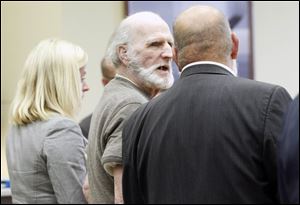
Judge declares mistrial in Bowman murder case
Jury unable to reach verdict in 1967 slaying
8/24/2011
Robert Bowman reacts after hearing jurors were unable to reach a verdict in his trial. He is charged with murder in the 1967 death of 14-year-old Eileen Adams.
After nearly 12 hours of deliberations -- and a night spent sequestered -- a Lucas County Common Pleas Court jury was released Tuesday after being unable to reach a verdict in the murder trial of Robert Bowman.
Bowman, 75, is charged with murder in the first degree for the 1967 slaying of 14-year-old Eileen Adams. He remains in custody in lieu of $500,000 bond and was returned to the jail Tuesday.
A Monday court date was set to discuss the status of the case.
Judge Gene Zmuda ordered a mistrial and discharged the jury at about noon. He said the jurors reported they were unable to reach a verdict and that there was "no probability" that the group could come to a consensus.
Jurors declined to comment as they were escorted out of the courthouse by security. One juror, who would not give her name, said the indecision came down to 10-2 vote.
Greg Gilchrist, an assistant professor from the University of Toledo college of law, noted that hung juries are not a rarity. He said it can occur as 12 individuals from various backgrounds and with independent thoughts are asked to agree.
Mr. Gilchrist added the prosecutor's office will have to decide whether to retry the case.
"What generally happens is that the government will assess whether they will prosecute the case again," Mr. Gilchrist said. "If it was a 10-2, majority to convict, I think it's fair to say many prosecutors would see that as a viable basis to retry."
Members of the Adams family -- most of whom watched the entire trial -- were in the courtroom when the jury was excused. Some shed tears. Others showed signs of disbelief and dismay.
The family, including four of Ms. Adams' siblings, declined to comment.
A total of 17 witnesses testified over seven days during the trial that included more than 85 state exhibits and more than a dozen from the defense. Attorneys gave lengthy closing arguments Monday outlining the days' worth of evidence presented.
Witnesses testified that the Sylvania Township girl was last seen Dec. 18, 1967, on her way from school to her sister's West Toledo home.
Her body was found bound in a rug on Jan. 30, 1968, in a Monroe County field. Retired law enforcement testified that her hands were tied in front of her, her ankles were bound to a cord attached to her neck, and a nail had been driven into her skull.
Despite hundreds of tips, law enforcement was not able to pinpoint a viable suspect and the case went cold, witnesses stated.
Bowman became a suspect in the killing in 1981 when his ex-wife, Margaret, made statements to Toledo police.
Ms. Bowman testified last week that she found a teenage girl tied up in the basement of her home on West Sylvania Avenue. She further testified that her enraged husband told he would have to kill the captive because his wife had gotten involved in his "business."
Retired detectives testified that they tracked down Bowman to an abandoned restaurant in Florida to interview him in early 1982. There, they discovered two dolls -- a Spider-Man doll with its hands and feet tied and a needle between its eyes and the head of a Ken doll with a nail protruding from the back of the head. The dolls were shown to jurors.
The detectives testified that they interviewed Bowman for several hours but did not arrest him and acknowledged that the case went cold again.
Cold-case detectives reopened the investigation in 2006 and re-examined the evidence to look for possible DNA. Several experts -- including one defense witness -- testified that a degraded DNA sample was found in a semen stain on the victim's clothing. When compared to Bowman's DNA, he could not be excluded as the contributor.
The experts opined that the random likelihood that the DNA would be found in the general population was 1 in 4.15 million.
In 2006, an arrest warrant was issued for Bowman. He was arrested in California two years later and was indicted in Lucas County on Oct. 31, 2008.
If convicted of murder in the first degree, he faces life in prison.
During closing arguments Monday, attorney Pete Rost asked jurors to be wary of deciding the case on sympathy.
Mr. Rost said the case rests with Ms. Bowman's testimony and the DNA results but challenged the credibility of each. Specifically, he said that Ms. Bowman "wasn't believable in 1981 to the point of arresting Robert Bowman" and that the DNA testing "has problems."
Mr. Rost asked jurors not to "skim over" the evidence but instead consider each and whether it rises to the burden of proof beyond a reasonable doubt.
The jury began deliberating at about 12:15 p.m. Monday. After about six hours, they indicated that they could not reach a consensus. Judge Zmuda gave them additional instructions and asked them to return to deliberations.
The group deliberated into the late evening and was then transported for the night to a hotel where they were sequestered. They continued deliberating for just under three hours Tuesday before concluding they were hung.
Judge Zmuda issued a gag order in early 2009, which prevents attorneys involved in the case from discussing the previous trial or any future plans.
Contact Erica Blake at: eblake@theblade.com or 419-213-2134.